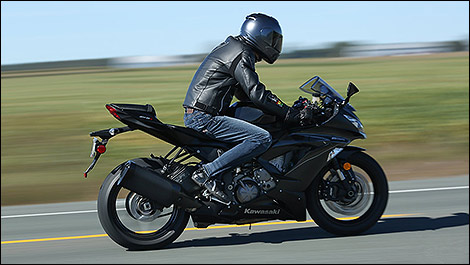To fully appreciate technologies they need to be understood, properly adjusted, and mastered. While many old-school riders hate modern electronic aids designed to make their life easier, no one can deny the benefits in terms of handling and safety.
True, earlier versions of these systems (pre-2010) offered little adjustability and proved too invasive under acceleration and braking, limiting power and fun. However, today's systems have significantly evolved and are 100% adjustable on premium bikes. Kawasaki has been a model of transparency and precision since 2011, and Yamaha since the 2015 model year. You have to understand that they do not work
for you, but rather
with you -- like an extension of your body and brain providing extra confidence to attack the road (or the track) and push the limits safely.
 |
| Photo: Philippe Champoux |
Riding modes
This feature allows riders to select the engine map that best suits their needs and style. It typically comes down to Low, Medium, and Full power, although some manufacturers use fancy terms to specify what the various modes are for: Rain (road and wet pavement), Normal, Sport (slick, dry pavement), and Track.
Traction control with lean-angle sensor
Unlike road-oriented traction control systems that kill the throttle at the slightest loss of grip (touring and standard bikes), the latest systems found on sport bikes and superbikes (post-2010) maximize traction by smartly reducing engine power, thus allowing riders to push their bike right to the limits of grip and exit corners like a champ.
Fact: You need a certain amount of drifting to effectively power your way out of a corner. Without traction control, the rider must induce such drifting and exert precise control throughout the entire manoeuvre to prevent a highside. In Slick mode (Japanese bikes and BMW S1000RR) or at level 1-2 (Ducati, Aprilia, MV Agusta), sophisticated electronics will allow some drifting by ensuring the optimum amount of rear-wheel skid regardless of road or track conditions. Speaking of which, the system monitors several key parameters such as lean angle, wheelie angle, throttle opening, selected gear, and tire grip every five milliseconds to determine the appropriate adjustments in real time.
Advanced ABS
Unlike standard ABS, Bosch's Race ABS (found on nearly all superbikes since 2009) uses the same array of sensors as traction control along with a hydraulic pressure sensor and a dedicated control unit.
This system optimizes brake pressure to prevent wheel lock-up and/or reduced braking performance. It also improves brake feel, eliminates rear-wheel lift, and maintains steady deceleration by monitoring engine brake. With “combined” ABS systems, the front brake lever also activates the rear brake. Be careful, though: When past a certain lean angle, most of these systems cease to operate.
Wheelie control
This form of electronic aid eliminates or at least reduces front-wheel lift at full throttle in order to maximize aerodynamics and top speed, not to mention safety. Without it, the rider has to control wheelies by applying slight pressure with the rear brake.
Adjustable engine brake
The latest advances in electronic aids have made it possible to fine-tune engine brake as you enter a corner. The system will adjust to riding conditions, speed, and the selected gear. Some bikes even allow you to specify the desired amount of engine brake. If yours is not equipped with this particular technology, you can still adjust engine brake by using extreme precision as you release the clutch.
Shift assist
A shifting assistant allows you to upshift without clutching or releasing the throttle, which makes for quicker, smoother shifts. The latest systems (Ducati, BMW, HM-GP) also allow seamless downshifts without the need to use the clutch.
Launch control
As you take off from idle, this technology will automatically control acceleration to ensure quick, fuss-free sprints. The most sophisticated launch control systems even take care of the clutch. Just press the start button with the engine already idling, twist the throttle wide open, and abruptly release the clutch; the system will positively shoot you into another dimension.
Intelligent suspension
Electronically controlled, intelligent suspension systems adjust compression and rebound damping in real time in order to optimize chassis geometry and consequently handling at specific areas of a track or on the road. It feels like having your own suspension technician right there with you at all times. Just remember to properly set the sag first. Without this system, you'll need to call on a specialist to find the ideal settings for a given track and conditions.
Slipper clutch
A slipper clutch is a mechanical aid that prevents the rear wheel from locking up during sudden downshifts, which greatly improves stability as you decelerate and start to attack a corner. As a rider, you still need to master rev-matching in order to keep the bike settled during this crucial action.
All in all, remember that modern electronic aids work with you and not for you. They are not infallible, and caution is always recommended. Consider them your on-board assistant or guardian angel there to help you quickly hone your riding skills by effectively and significantly limiting the risk of falling off the bike.

